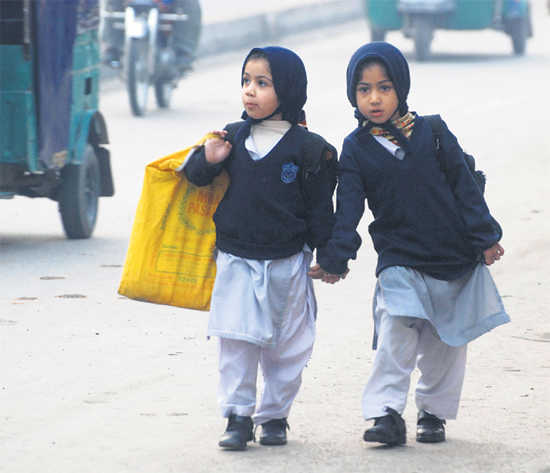
LOW LEARNING: Schoolgirls heading to their school in Peshawar. REUTERS
Maha Qasim
RECENTLY, I spent a semester training 10th-grade science teachers at a school for low-income students in Karachi. All of them had a Master's degree in science or engineering and had been teaching for at least three years. However, when I asked them to explain the difference between a concave and a convex mirror, a staple of the FSc. physics textbook, they drew a complete blank. The state of teachers' scientific knowledge left me feeling more than a little anxious about the state of education in the classroom.
According to the World Development Report 2018, the learning deficit begins in early childhood and persists throughout a student's educational trajectory. Failure to diagnose the problem early eventually results in a poorly skilled workforce which spells doom for a country's economic future. In some developing nations, education systems have failed to sufficiently prepare graduates entering the workforce. Surveys conducted by the World Bank show that many workers take up jobs that require minimal amounts of reading or math since they can barely read or do basic arithmetic. Further, in a rapidly changing technological landscape, workers are required to update their skill-set regularly. Because many workers' foundations in literacy are weak, they cannot be trained to acquire more advanced technical skills for higher level jobs, effectively condemning them to a life of poverty and exploitation.
The prevailing situation in Pakistan reflects this outcome. The majority of Pakistan's workforce is employed in the informal sector in manufacturing and production, construction and transport, community and personal services. Since the informal sector is unregulated, workers are often underpaid and exploited with no provision for their health, safety or general well-being. Thus, the low-learning trap translates into limited social mobility.
The latest Annual Status of Education Report 2016 highlights some of the shortfalls in Pakistan's education system. School enrolment stands at 81 per cent. However, the research shows that even those enrolled in school aren't learning much. At the national level, only half of the children in fifth grade can read a story in their native language and less than half a sentence in English or divide 48 by 15.
The dropout rate is even more alarming. For every 15 children in first grade, only four make it to 10th grade. Despite improvements in school infrastructure, students in over 40pc of government schools still do not have access to potable water or a functioning toilet. Students of different grades are often forced to sit in one classroom and follow the same curriculum. The result is a harassed teacher and increasingly bored and disengaged students with zero motivation to learn.
The report also finds that children enrolled in private schools are ahead of their government counterparts. For parents who can't afford private school fees, this disparity further amplifies the learning gap. Poor children are already at a disadvantage due to the less-than-ideal conditions at home. Unfortunately, the current education system ensures that they remain locked into lives of poverty.
The World Development Report's findings show that due to debilitating factors ranging from malnutrition to lack of parental support, insalubrious home environments and financial barriers, poor children learn the least, which hurts them the most. To break out of the low-learning trap, the World Bank recommends a complementary three-pronged approach. First, measure learning through proper metrics, second, incorporate innovative evidence-based approaches to learning in the classroom, and third, streamline the learning process by ensuring that all parts of the education system work in tandem. The report emphasises that incentives do not need to be high stakes (or financial) to affect behaviour. In Pakistan for example, simply reporting children's test scores to parents improved learning outcomes by increasing competition among schools due to pressure from parents' to improve learning standards.
Investing in quality education can yield major economic and social benefits in the both the medium and long term. Individuals benefit from improved employment opportunities, increased earnings and better health. Societies benefit from improved economic growth, poverty reduction, innovation, stronger institutions and better social cohesion.
We need to ensure that students are actually learning. Students need to be motivated to learn on their own. Teaching them to learn will empower them to adapt to the changing economic future which increasingly emphasises learning on the job.
By arrangement with Dawn



























